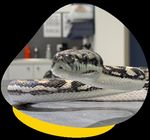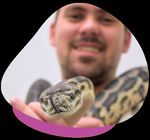Caring For Carpet Pythons - The Unusual Pet Vets
←
→
Page content transcription
If your browser does not render page correctly, please read the page content below
Caring For Carpet Pythons
Carpet pythons are a group of snake species found in
Australia and nearby islands. They are known for their
unique patterns and colours and are popular among reptile
enthusiasts.
Carpet pythons typically grow to an average of 2-3 meters
and are non-venomous. They are known to be hardy, and
with proper husbandry and a good understanding of their
requirements, they can do well in captivity.
Carpet pythons’ individual requirements come down to what subspecies you are keeping;
however, their recommended general husbandry guidelines can be found below.
Housing
Carpet pythons are best housed separately, except when breeding. Hatchlings can be kept
in small lunch box-size tubs providing suitable hides, a clean and fresh water source,
appropriate heating and a climbing branch. Subadult or adult pythons can be adequately
housed indoors in a ventilated vivarium and generally prefer an arboreal set-up.
Enclosures must be secure and escape-proof. Wire-fronted vivarium’s are not suitable for
snakes. The vivarium must be adequately ventilated. A build-up of condensation could
indicate damp conditions, poor ventilation, or both. Therefore, appropriate measures
should be taken to avoid such conditions as they can predispose to various medical
problems.
Captive Environment
Vivarium furnishings should be kept simple, with no
sharp edges or points and several appropriate hides.
These should be constructed so you can access the snake
at any time. Keep the vivarium furnishing to a minimum
to allow plenty of room for the snake to move around
and exercise.
The floor covering or substrate should be easily
removable for cleaning. Some options are newspaper,
paper towel, recycled paper cat litter, sand, woodchipsand artificial turf. Each of the substrates noted has its pros and cons associated with their use. For example, newspaper is cheap, clean and easy to change however doesn't look as aesthetically pleasing as some of the other substrate options. Sand and recycled paper cat litter generally look nicer but carry risks if the snake accidentally ingests any substrate. Carefully consider the most appropriate substrate for your python and its environment. A number of hide boxes or rock crevices must be provided to allow the snake to retreat and thermoregulate their own temperature at different points of the cage. Avoid adhesive tape inside the vivarium, as this can come loose and pose a risk to your snake. Temperature and Lighting Pythons like to bask beneath a spotlight or radiant heat panel for several hours each day. However, a heating pad or cable on or under a small section of the floor will allow ongoing access to a constant heat source. It is crucial that the snake is unable to wrap itself around or have any direct physical contact with the heat source, as this can lead to life-threatening thermal burns. Generally, the heat and light source should be switched on, usually by means of a timer switch, for around 12 hours per day during the summer months, with the photoperiod (the time the light is on) reduced to 10 hours during the winter months. The ambient temperature at the warm end of the cage at night should not be allowed to drop lower than 20C for any extended period. With hatchling pythons (
Food
Carpet pythons will eat mice or rats of an appropriate size in relation to their body size.
Young pythons will become very active when hungry and require feeding every 7 – 10 days.
Adults will often be ready to feed immediately after defecation. Frozen food items must be
completely thawed before they are offered. This can be achieved by thawing the prey item
in a container filled with warm water. The water may need to be changed to keep it warm
enough to fully thaw the food through. Discard any food item not taken and never refreeze
a thawed food source.
Most adults should be fed every 1-4 weeks; many snakes will continue to eat any food
source that is offered, so it is important to be observant as some individuals may become
obese.
Adult snakes may feed regularly for several months and then abstain from eating for long
periods, occasionally for as long as six months. If the snake is reluctant to take food off the
floor, offer it held in tongs. Remember, they are low-energy specialists spending most of
their time doing nothing apart from basking. Avoid feeding if the snake has not been kept
warm (i.e. during the winter months) or if sufficient heat is not available after feeding, as
the food may decompose and start rotting in the stomach before it can be digested,
resulting in regurgitation, gastrointestinal disease or even the death of your snake.
Captive Behaviour and Breeding
Young pythons may be nervous and bite. Most will
settle with time and tolerate handling. Never grip the
snake and restrict its movement during handling, as it
will become alarmed. Do not handle a snake for several
days after it has eaten, nor when in pre-slough
condition or from the commencement of the "milky"
eyes until it has shed its skin.
Probing by an experienced reptile vet can determine
the sex of your snake and should not be attempted by
those inexperienced as if done inappropriately, and serious damage can occur.
Female pythons usually grow slightly longer and heavier than males; however, the adult size
often relates directly to their food intake and feeding regularity; hence some males can be
larger than females.
Breeding success is improved by allowing a drop in the low nighttime temperatures in both
sexes for 6-8 weeks during the winter months. Mating occurs in winter, with eggs beingdeposited in late spring or early summer. Adult males are
likely to fight during breeding season and should not be
allowed to contact each other.
Health Problems
Reptiles, in general, are very good at hiding their health
problems until they have become severe. For this reason,
it is recommended your python is checked by an
experienced reptile veterinarian every 6-12 months.
Common problems where veterinary advice is
recommended are respiratory diseases, mouth infections, constipation, dysecdysis (trouble
shedding), prolonged inappetence outside of the cooler months of the year, lethargy,
diarrhoea, abnormal movement, and regurgitation.
Quarantine
The length of quarantine is a contentious area, with many different protocols implemented
worldwide. With recent advancements in our understanding of reptile viruses and diseases,
we may not be able to 'out-quarantine' some of the newly discovered reptile viruses, which
complicates recommending a time frame.
Most reptile veterinarians now recommend a quarantine
period of at least six months for newly acquired snakes and
in some cases combine with screening tests. Quarantined
animals should be kept in a separate room with no shared
contact or airspace. Any handling, feeding, or cleaning of
the cages should be completed after all the other non-
quarantined animals. If further work needs to be done with
the rest of the collection after the animals are in quarantine,
then a complete change of clothes and a thorough
disinfection of hands and any equipment used is
recommended.
If you have any further questions about your snake, please don't hesitate to contact your
local Unusual Pet Vets team.You can also read

























































